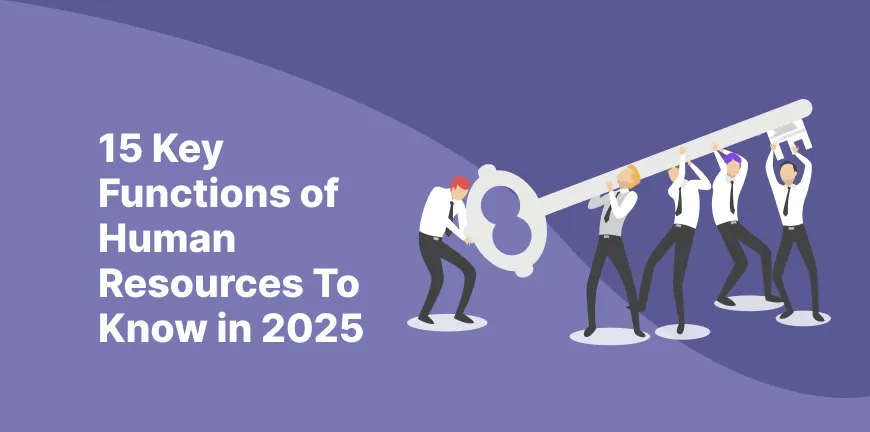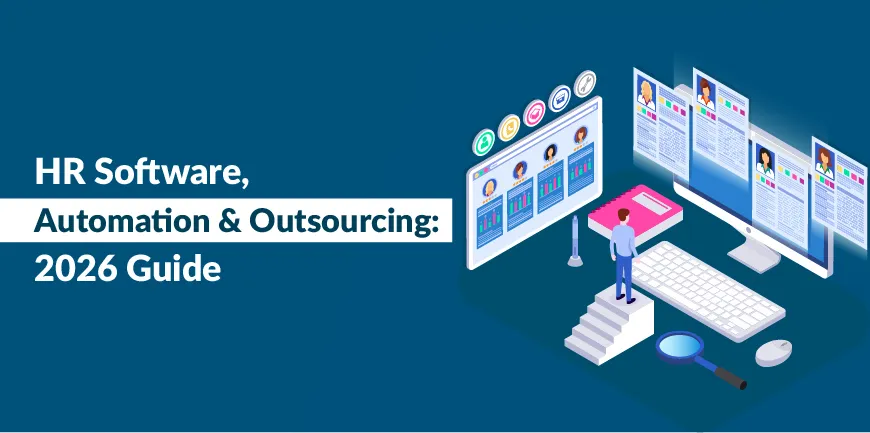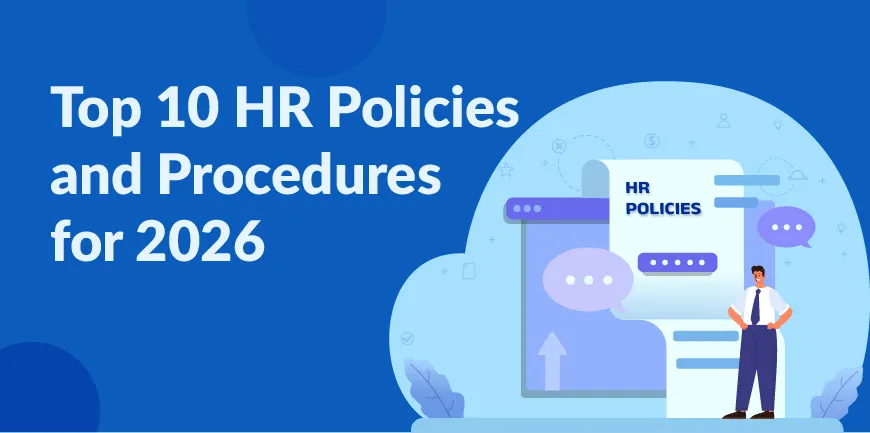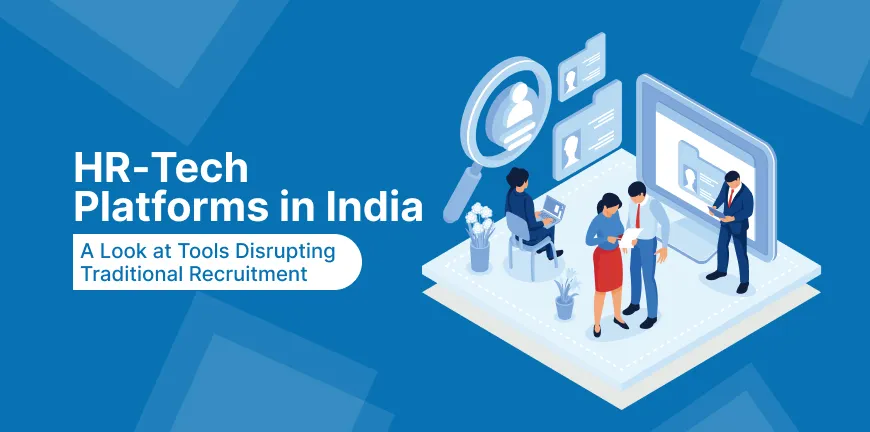
Top 11 Leadership Skills to Master in 2025
13/10/2025
Top 10 Foreign Languages in Demand for Indian Professionals
13/10/2025- The Changing Landscape of Human Resources
- Top 15 HR Functions Every Organization Should Know in 2026
- How Technology Is Reshaping HR Functions
- HR Metrics and Analytics: Measuring Function Effectiveness
- Challenges Facing Modern HR Functions
- Future-Ready HR: Skills and Strategies for 2026
- Conclusion
- Key Takeaways
- FAQs
HR functions have evolved from traditional administrative support to becoming strategic pillars of organizational success. Once limited to payroll and personnel management, modern HR now drives workforce planning, talent acquisition, and employee experience initiatives that deliver measurable business impact.
As we approach 2025, HR functions require greater adaptability, technological expertise, and data-driven decision-making to meet shifting workforce demands. Strategic priorities now include digital transformation, diversity and inclusion programs, and advanced analytics to strengthen retention and performance.
This HR functions guide explores the most essential HR functions growth-focused organizations must master to build resilient, innovative, and future-ready workforces in today’s fast-changing business environment.
The Changing Landscape of Human Resources
The human resources landscape has undergone fundamental shifts that define organizational expectations for 2026. Traditional personnel management has given way to dynamic, technology-enabled approaches focused on strategic value creation rather than administrative efficiency alone.
Remote and hybrid work arrangements have permanently altered how the HR department functions across organizations. What started as temporary pandemic solutions has become standard business practice. Moreover, HR departments now redesign core functions to support distributed workforces effectively. This shift extends beyond logistical adjustments to fundamental changes in how companies attract, develop, and retain top talent.
Employee experience has become the cornerstone of modern HR operations. Organizations recognize that workforce satisfaction directly drives productivity, innovation, and business results. This marks a significant departure from previous approaches, where HR primarily served business requirements rather than employee needs. Progressive HR departments design people-centered policies addressing the complete employment journey from recruitment through retirement.
Data analytics capabilities have become essential for effective HR management. HR professionals now use sophisticated analysis to inform workforce planning, compensation strategies, and performance evaluation decisions rather than relying on intuition and historical practices. This evidence-based approach enables precise alignment between HR functions and organizational objectives.
Skills requirements continue evolving at an unprecedented speed, creating both challenges and opportunities for HR functions in an organization. Technical expertise alone no longer guarantees role success. Adaptability, emotional intelligence, and creative problem-solving have emerged as equally important capabilities. HR departments develop new frameworks for identifying, developing, and measuring these complex competencies.
Diversity, equity, and inclusion initiatives have shifted from peripheral concerns to core strategic priorities. Organizations understand that diverse teams deliver superior results when supported by inclusive cultures and equitable systems. HR functions in HRM increasingly focus on eliminating hiring bias, creating inclusive workplace policies, and measuring diversity outcomes with the same rigor applied to other business metrics.
Economic uncertainty has prompted organizations to reevaluate HR department functions entirely. Forward-thinking companies position their people operations as strategic investments, driving competitive advantage rather than viewing HR as a cost center. This perspective shift means HR professionals participate in high-level strategic planning rather than simply executing decisions made elsewhere.
Traditional employment models continue fragmenting as gig work, contract positions, and project-based arrangements become commonplace. This evolution requires HR to develop approaches for managing blended workforces comprising traditional employees and various contingent workers. Additionally, HR functions must address complex questions about classification, compensation, and culture in these mixed environments.
Regulatory compliance has grown increasingly complex as governments introduce new labor protections, privacy requirements, and workplace safety standards. HR departments navigate this expanding regulatory landscape while maintaining operational efficiency and supporting business growth. This balancing act demands greater legal expertise within HR functions and closer collaboration with legal and compliance teams.
Technology adoption across HR accelerates continuously. Artificial intelligence and automation reshape basic HR functions, including recruitment, onboarding, and performance management. These technologies offer unprecedented efficiency while raising important questions about human judgment, bias mitigation, and the appropriate balance between automation and personal interaction in people management.
Leadership development approaches evolve to meet the demands of increasingly complex business environments. Strategic HR functions now emphasize collective leadership capabilities distributed throughout organizations rather than focusing narrowly on individual performance. This distributed approach enables greater adaptability and innovation while reducing dependency on individual executive talents.
Wellbeing initiatives have expanded beyond traditional health benefits to encompass mental health support, financial wellness programs, and work-life integration solutions. These approaches recognize that employee performance depends on holistic well-being rather than compartmentalized health aspects. Modern HR functions view wellbeing as a strategic priority rather than merely benefits administration.
These shifts in human resources reflect broader changes in how work gets accomplished and how organizations create value. Companies that understand these developments can position their HR functions and policies to drive sustainable competitive advantage while creating meaningful work experiences for their workforce.
Top 15 HR Functions Every Organization Should Know in 2026
Organizations preparing for workplace complexities in 2026 must master critical HR functions that drive sustainable business success. These 15 key HR functions form the backbone of effective people management strategies that forward-thinking companies implement to excel in competitive business environments.
1. Strategic Workforce Planning
Strategic Workforce Planning aligns human capital requirements with long-term business objectives through strategic workforce planning. This function analyzes current workforce capabilities, identifies future skill requirements, and develops strategies to bridge talent gaps. Advanced HR departments now use sophisticated modeling techniques to forecast talent needs across various business scenarios and market conditions.
2. Talent Acquisition and Recruitment
Modern talent acquisition extends beyond traditional hiring to include employer branding, candidate experience design, and strategic sourcing approaches. Organizations excelling in this function build comprehensive talent pipelines through social recruiting, employee referrals, and targeted outreach campaigns. Successful recruitment strategies assess cultural fit and growth potential alongside technical qualifications.
3. Employee Experience Management
This function designs and optimizes touchpoints throughout the employee journey to create meaningful work experiences. Progressive organizations map the complete employee lifecycle from recruitment through retirement, identifying critical moments and designing interventions that enhance engagement and satisfaction. Employee experience strategies incorporate personalization to address diverse workforce requirements.
4. Performance Management
Contemporary performance management moves beyond annual reviews to emphasize continuous feedback, coaching, and development initiatives. These roles and functions include frequent check-ins, peer recognition systems, and agile goal-setting frameworks that align individual contributions with organizational objectives. Data-driven performance approaches identify patterns and provide insights for effective talent decisions.
5. Learning and Development
Modern learning and development HR functions create continuous learning ecosystems supporting immediate skill needs and long-term career growth. Effective learning strategies blend formal training, experiential learning, mentoring, and just-in-time resources accessible through digital platforms. Organizations focus on developing adaptable learning mindsets rather than specific technical skills alone.
6. Total Rewards Management
This function has expanded from basic compensation administration to holistic rewards strategies encompassing financial incentives, benefits, recognition programs, wellbeing initiatives, and career opportunities. Sophisticated rewards approaches incorporate personalization options, allowing employees to customize packages according to individual preferences and life stages.
7. Diversity, Equity, Inclusion, and Belonging (DEIB)
DEIB has evolved from compliance-focused initiatives to strategic imperatives driving innovation and business performance. This function includes developing inclusive hiring practices, creating equitable advancement pathways, fostering psychological safety, and measuring representation across organizational levels. Effective DEIB strategies address both visible and invisible dimensions of diversity.
8. HR Analytics and People Insights
Data-driven decision-making has become central to effective HR management across organizations. This function encompasses collecting, analyzing, and applying workforce data to enhance talent strategies and business outcomes. Advanced analytics capabilities enable predictive modeling for retention risks, performance patterns, and engagement drivers that inform proactive interventions.
9. Organizational Design and Development
This strategic function structures teams and workflows to maximize effectiveness while supporting cultural values. Such strategic HR functions include designing responsive organizational structures, clarifying roles and decision rights, and developing change management capabilities. Forward-thinking organizations adopt flexible design principles that enable rapid adaptation to market changes.
10. Digital HR and Workplace Technology
Managing the digital employee experience represents a critical HR function for modern organizations. This includes selecting, implementing, and optimizing HR technologies that enhance efficiency while creating intuitive user experiences. Progressive organizations develop comprehensive digital workplace strategies that integrate various platforms while maintaining valuable human connection points.
11. Cultural Stewardship
HR increasingly owns responsibility for shaping and maintaining organizational culture across business operations. This function involves articulating core values, designing cultural rituals and practices, and measuring cultural health through feedback mechanisms. Effective cultural stewardship balances preserving essential cultural elements while evolving others to support changing business conditions.
12. Employee Relations and Engagement
This function builds productive relationships between the organization and its workforce through systematic approaches. It encompasses developing communication channels, conflict resolution processes, and engagement strategies that foster trust and commitment. Modern employee relations approaches emphasize transparency, psychological safety, and collaborative problem-solving methods.
13. Compliance and Risk Management
While traditional compliance remains important, this function has expanded to include identifying and mitigating people-related risks. This includes developing policies that balance legal requirements with operational flexibility, ensuring ethical workplace practices, and preparing for emerging regulatory changes. Forward-thinking organizations view compliance as an opportunity to strengthen organizational values.
14. Wellbeing and Resilience
Supporting holistic employee wellbeing has become a strategic HR priority across industries. This function encompasses physical health initiatives, mental health resources, financial wellness programs, and work-life integration support. Effective well-being strategies recognize the connection between personal resilience and organizational performance during periods of disruption.
15. Leadership Development
Building leadership capability at all organizational levels represents a critical HR function for business success. This includes identifying leadership potential, creating development pathways, and designing succession planning processes. Modern leadership development approaches focus on building adaptable, inclusive leadership styles suited for complex business conditions.
These 15 HR department functions collectively form the foundation of human resources management in 2026 evolving workplace. Organizations that master these capabilities position themselves to attract top talent, build engaging cultures, and achieve sustainable competitive advantage through their people strategies.
How Technology Is Reshaping HR Functions
Technology has become central to modern HR operations, changing how organizations manage their workforce across every business function. Digital tools now enable HR departments to operate more efficiently while creating strategic value that directly supports business objectives.
AI-powered recruitment systems process thousands of applications within minutes, identifying qualified candidates through sophisticated matching algorithms. These platforms analyze hiring patterns and continuously improve their ability to predict candidate success. Organizations using advanced recruitment technology reduce time-to-hire significantly while improving quality of hire metrics.
Cloud-based HR management systems have eliminated routine administrative tasks that once consumed substantial resources. Payroll processing, benefits administration, and attendance tracking now operate through integrated platforms accessible from any location. This operational efficiency allows HR professionals to focus on strategic activities that drive business performance.
Digital platforms have enhanced employee engagement and experience management through several key capabilities:
- Real-time feedback systems that replace traditional annual review cycles.
- Customized learning paths aligned with individual career development goals.
- Employee self-service portals that reduce administrative workload.
- Recognition platforms that strengthen workplace culture through immediate appreciation.
Data analytics capabilities have become essential for strategic HR decision-making. Organizations now examine workforce metrics to make evidence-based decisions about compensation, succession planning, and talent development. Predictive analytics identify retention risks early, enabling proactive interventions that prevent valuable employee departures.
Training and development programs benefit significantly from virtual and augmented reality applications. Complex procedures can be practiced in digital environments without expensive physical simulations. This approach reduces training costs while ensuring consistent experiences across distributed teams.
Mobile technology extends HR services beyond traditional office boundaries. Field workers and remote employees complete benefits enrollment, performance assessments, and training modules through smartphone applications. This accessibility proves especially valuable for organizations with geographically dispersed workforces.
However, technology implementation presents certain challenges that organizations must address. Many HR teams require upskilling to maximize new system capabilities. Successful adoption typically demands coordinated investment in both technology and professional development to achieve desired outcomes.
Data security and privacy concerns require careful attention as HR systems collect increasingly detailed employee information. Organizations need robust governance frameworks that protect sensitive data while maintaining regulatory compliance and employee trust.
Technology serves best as an enhancement to human judgment rather than a replacement for professional expertise. The most effective HR departments use automation to eliminate routine tasks while creating opportunities for meaningful employee interactions and strategic planning.
Several emerging technologies will likely influence HR functions in the coming years:
- Natural language processing for workplace communication analysis
- Blockchain applications for credential verification
- Biometric systems for enhanced security and wellness monitoring
- Edge computing capabilities for remote work analytics
Organizations that strategically implement HR technology gain competitive advantages through improved talent acquisition, development, and retention capabilities. The greatest benefits come from aligning technology investments with specific workforce objectives rather than adopting solutions without a clear business purpose.
Technology enables HR departments to shift from reactive to proactive workforce management. Routine administrative tasks become automated, freeing HR professionals to design exceptional employee experiences that support both individual career growth and organizational success.
HR Metrics and Analytics: Measuring Function Effectiveness
Measurement drives successful HR operations, with data-focused decision-making distinguishing high-performing departments from those operating without clear direction. Organizations now recognize that HR metrics and analytics create the foundation for strategic workforce decisions that generate measurable business impact.
Effective measurement begins with establishing clear key performance indicators aligned with business objectives. These indicators typically fall into several focused categories:
- Recruitment and Talent Acquisition: Time-to-fill, cost-per-hire, quality of hire, source effectiveness
- Employee Performance: Productivity metrics, performance ratings distribution, goal achievement rates
- Retention and Engagement: Turnover rates, retention by department, engagement scores, and absenteeism
- Learning and Development: Training completion rates, skill acquisition metrics, certification attainment
- Compensation and Benefits: Salary competitiveness, benefits utilization, compensation-to-revenue ratio
- Overall HR Operations: HR-to-employee ratio, HR service delivery metrics, policy compliance rates
Advanced organizations employ sophisticated analytical approaches that reveal deeper workforce insights. Descriptive analytics examine historical patterns in workforce data, answering “what happened” questions about past performance. Diagnostic analytics investigate cause-and-effect relationships, helping HR teams understand why certain trends occurred.
Predictive analytics represents the next step, using historical patterns to forecast future outcomes across various HR department functions. These tools identify which employees might leave within six months based on engagement patterns, performance trends, and market conditions. Prescriptive analytics suggest specific actions to address identified issues, turning data into actionable recommendations.
HR analytics demonstrate strategic value most clearly when measuring function effectiveness against business outcomes. Return on investment calculations for HR initiatives now provide concrete evidence of impact. Organizations track how recruitment process improvements affect time-to-productivity for new hires, or how leadership development programs correlate with increased team performance.
Leading organizations develop HR analytics maturity models to assess their capabilities. These models progress through stages: from basic operational reporting to advanced predictive capabilities and strategic analytics that directly inform business decisions. Each stage represents increasing sophistication in data collection, analysis methodologies, and application to strategic HR functions.
Developing effective measurement systems requires attention to several critical success factors. Organizations must ensure data quality and consistency across systems. Without reliable data, sophisticated analytics tools produce misleading results. HR analytics require technology infrastructure that integrates data from HRIS platforms, learning management systems, and performance tools.
Basic HR functions need clearly defined measurement frameworks with appropriate metrics at each analysis level. Organizations typically develop metrics hierarchies including operational indicators, tactical metrics, and strategic measures evaluating long-term impact.
HR professionals must develop data literacy skills to interpret analytics effectively and translate findings into meaningful actions. This shift requires ongoing development of analytical capabilities throughout the HR department.
Dashboard visualization provides particularly effective approaches for communicating HR metrics across organizations. Well-designed dashboards present key indicators in intuitive formats, enabling quick understanding of performance trends. These visual tools include drill-down capabilities, allowing users to explore underlying data patterns and identify specific improvement opportunities.
HR measurement best practices continue evolving as organizations gain analytics experience. Leading organizations align metrics with strategic priorities, establish clear measurement governance, build analytics capabilities gradually, and focus on generating actionable insights rather than producing reports.
Future HR metrics and analytics point toward greater integration with business intelligence systems. As HR functions align more closely with business strategy, measurement approaches will focus on demonstrating direct connections between people management practices and organizational performance. Organizations that master these measurement capabilities gain competitive advantages through more effective workforce decisions and strategic alignment.
Challenges Facing Modern HR Functions
Modern HR functions face significant obstacles while managing expanded responsibilities across rapidly evolving business environments. Economic uncertainties and workplace changes create complex challenges that can disrupt even well-structured people strategies.
1. Skill Gaps and Talent Shortages
Skill Gaps and Talent Shortages create the most pressing concerns for HR functions across industries. Specialized roles requiring advanced technical capabilities emerge faster than qualified candidates can be identified. This talent scarcity intensifies competition, increases compensation demands, and complicates traditional recruitment methods. HR departments simultaneously struggle with internal skill deficiencies, as many HR professionals lack the technical knowledge needed for advanced analytics or automation implementation.
2. Technology Adoption Difficulties
Technology Adoption Difficulties extend beyond basic implementation challenges. Technology offers substantial potential for enhancing HR functions, yet organizations often encounter resistance when introducing new systems. Employees familiar with established processes view digital tools with suspicion, seeing threats rather than opportunities. The rapid pace of technological evolution means HR departments frequently implement solutions that become outdated quickly, creating continuous cycles of disruptive change.
3. Remote Work Management Issues
Remote Work Management Issues have permanently changed basic HR functions in unexpected ways. Managing distributed teams introduces challenges around performance evaluation, cultural cohesion, and equitable advancement opportunities. HR departments must develop new frameworks for activities that previously relied on face-to-face interactions. Geographic flexibility also complicates compliance with different labor regulations across jurisdictions, adding legal complexity to routine HR functions and policies.
4. Multi-Generational Workforce Pressures
Multi-Generational Workforce Pressures create additional demands on HR departments managing diverse workforces spanning multiple age groups. Each generation brings different expectations for communication styles, work arrangements, career progression, and reward structures. HR functions in an organization must balance these varying expectations while maintaining policy consistency. Aging workforces in many industries create knowledge transfer challenges that threaten operational continuity when experienced employees retire without proper succession planning.
5. Mental Health and Burnout Management
Mental Health and Burnout Management has escalated dramatically, requiring HR departments to develop comprehensive wellness strategies. Traditional employee assistance programs prove insufficient as workers face compounding stressors from economic uncertainty, work intensification, and blurred professional-personal boundaries. Strategic HR functions increasingly include proactive mental health initiatives, yet many HR teams lack specialized expertise in this area.
6. Organizational Agility Requirements
Organizational Agility Requirements place substantial pressure on traditional HR roles and functions. Businesses requiring greater adaptability in response to market shifts need HR departments that can facilitate rapid workforce realignment while maintaining engagement during change periods. This balancing becomes particularly challenging when organizations expect both cost containment and people-focused initiatives simultaneously.
7. Ethics in Technology Implementation
Ethics in Technology Implementation presents complex challenges as HR departments deploy sophisticated technologies. Data privacy questions, algorithmic bias concerns, and appropriate workplace monitoring boundaries require careful navigation. HR professionals often find themselves balancing technological possibilities with ethical responsibilities, having few established frameworks for decision-making guidance.
8. Regulatory Compliance Complexity
Regulatory Compliance Complexity continues to intensify across jurisdictions, with expanding requirements around privacy, worker classification, and non-discrimination. HR departments must track evolving regulations while ensuring consistent application of HR functions and policies across diverse operational contexts. This regulatory burden diverts resources from strategic initiatives while creating significant non-compliance risk exposure.
9. Budget Constraints and ROI Expectations
Budget Constraints and ROI Expectations affect nearly all HR department functions as organizations scrutinize people-related expenditures more closely. HR leaders face increasing pressure to demonstrate quantifiable returns on talent program investments, yet struggle with attributing direct financial impacts to many modern HR functions. This emphasis on short-term metrics can undermine longer-term strategic initiatives with less immediate measurable outcomes.
10. Strategic Alignment Difficulties
Strategic Alignment Difficulties persist as HR departments balance operational responsibilities with strategic contributions. Despite recognition of HR’s potential strategic value, many organizations still view HR primarily through an administrative perspective. HR professionals must continuously advocate for strategic inclusion while managing day-to-day operational requirements.
These interconnected challenges reflect HR’s evolving organizational complexity. HR departments that navigate these obstacles while maintaining focus on core people priorities position themselves as genuine strategic partners rather than administrative functions. Organizations that develop innovative solutions to these challenges secure significant competitive advantages through enhanced workforce capabilities and engagement.
Future-Ready HR: Skills and Strategies for 2026
HR departments must build capabilities that extend well beyond conventional administrative expertise. Organizations preparing for 2026 already invest in competencies that will define successful hr functions in the coming years. Tomorrow’s HR professionals need technical mastery paired with distinctly human skills.
The emerging HR competency model emphasizes crucial skill domains that depart significantly from traditional requirements. Strategic business acumen leads these requirements: the ability to understand organizational objectives deeply enough to align hr department functions with broader business goals. HR professionals must develop financial literacy, market awareness, and the capacity to translate business metrics into people strategies.
Data interpretation capabilities represent non-negotiable requirements for future HR leaders. Tomorrow’s HR professionals need the ability to extract meaningful insights from complex datasets, identify relevant patterns, and make evidence-based recommendations that connect hr functions in an organization to business outcomes. This shift moves from intuition-driven to data-informed decision-making.
Design thinking methodology has become essential for HR teams reimagining employee experiences through human-centered approaches. This involves developing deep empathy for workforce needs, rapidly prototyping potential solutions, and continuously refining hr functions and policies based on actual user feedback rather than assumptions. HR departments can create interventions that genuinely address employee pain points.
Digital fluency encompasses much more than familiarity with HR technologies. Future-ready HR professionals must comprehend how various digital platforms interconnect, recognize automation opportunities, and understand potential implications of emerging technologies on basic hr functions. This technical foundation allows HR teams to collaborate effectively with IT departments while making informed decisions about technology investments.
Change facilitation skills have become increasingly vital as organizations navigate constant shifts. Successful HR professionals now require capabilities in change management frameworks, stakeholder engagement strategies, and communication approaches that foster adaptation. These competencies enable hr roles and functions to serve as organizational change agents rather than simply implementing directives developed elsewhere.
Alongside these technical capabilities, certain distinctly human competencies have grown more valuable. Emotional intelligence, the ability to recognize, understand, and manage emotions in oneself and others, provides the foundation for effective leadership coaching, conflict resolution, and cultural development. This skill enables HR to address the human dimensions of modern hr functions that technology cannot replicate.
Ethical reasoning frameworks help HR navigate complex decisions about workplace surveillance, algorithmic management, and data privacy. As strategic hr functions incorporate more sophisticated technologies, HR professionals must develop robust ethical decision-making approaches that balance organizational interests with individual rights and societal expectations.
Creativity and innovation skills allow HR teams to develop novel solutions to persistent workforce challenges. Applying structured innovation methodologies to hr functions in HRM departments can move beyond conventional approaches to discover differentiated people strategies that create competitive advantage.
Resilience and adaptability represent fundamental requirements for future HR professionals. The pace of workplace evolution continues to accelerate, demanding HR practitioners capable of maintaining effectiveness amid constant change and ambiguity. This adaptability extends to considering alternative models like outsourcing hr functions when appropriate for organizational needs.
Cross-cultural competence has become essential as workforces grow increasingly global and diverse. Future HR professionals need capabilities in cultural intelligence, inclusive leadership practices, and global mindsets that enable effective management across different cultural contexts.
Organizations building these future-focused capabilities benefit from several proven development strategies. Experiential learning approaches, including stretch assignments, cross-functional projects, and business immersion experiences, typically yield greater skill development than traditional classroom training. Mentorship programs connecting emerging HR professionals with seasoned business leaders provide invaluable context and guidance during capability development.
Professional certifications focused on emerging HR competencies offer structured development pathways. Organizations increasingly recognize that skill-building must extend beyond formal programs to include continuous learning habits embedded in daily work. Collaborative learning communities where HR professionals regularly share insights, challenges, and innovative practices across organizational boundaries represent particularly successful approaches.
Conclusion
Mastering key HR functions is no longer just an operational priority—it’s a strategic imperative for business success. As technology transforms traditional processes, organizations that blend digital capabilities with human-centric strategies gain a powerful competitive edge.
This HR functions guide equips readers with practical insights into the 15 essential HR functions, helping them align talent strategy with business goals. Whether you’re scaling a startup or optimizing a large enterprise, understanding these functions can enhance workforce agility, strengthen leadership pipelines, and drive measurable performance.
By applying these principles, organizations can turn HR into a true engine of growth and innovation.
Key Takeaways
- Strategic workforce planning emphasizes cultural fit, growth potential, and strong talent pipelines beyond traditional hiring.
- AI-driven recruitment, predictive analytics, and digital tools streamline HR operations while enabling smarter, data-based decisions.
- Employee experience management focuses on personalized strategies across the entire lifecycle, from onboarding to retirement.
- Predictive data analytics empowers organizations to forecast retention risks and optimize strategic workforce planning effectively.
- Future-ready HR functions demand hybrid skills combining digital fluency, data interpretation, emotional intelligence, and ethical adaptability.
FAQs
1. What are the key HR functions expected to be crucial in 2026?
The key HR functions for 2026 include strategic workforce planning, talent acquisition, employee experience management, performance management, and HR analytics.
2. How is technology transforming HR functions?
Technology is revolutionizing HR through AI-powered recruitment, predictive analytics, and digital platforms. These advancements are eliminating routine administrative tasks, enabling data-driven decision-making, and creating opportunities for more meaningful human interactions in the workplace.
3. What skills will HR professionals need to develop for future readiness?
Future-ready HR professionals will need to develop a combination of technical and human skills. These include data interpretation, digital fluency, design thinking, emotional intelligence, ethical reasoning, and cross-cultural competence.
4. How can organizations measure the effectiveness of their HR functions?
Organizations can measure HR effectiveness by establishing clear metrics aligned with business objectives. This includes tracking KPIs related to recruitment, employee performance, retention, learning and development, and overall HR operations.
5. What are the main challenges facing modern HR functions?
Modern HR functions face several challenges, including skill gaps and talent shortages, technological adaptation hurdles, remote work complexities, and increasing demands for organizational agility.
Contact Us For Business Enquiry

Rajkumar Shanmugam
Rajkumar Shanmugam is the Head of HR at ALP Consulting, bringing over 19 years of comprehensive HR leadership experience across India and international markets. His expertise spans talent acquisition, employee relations, performance management, compliance, and HR transformation. Rajkumar has a proven track record of driving people-centric initiatives, enhancing workplace culture, and aligning HR strategy with business goals. With extensive experience in US staffing operations and global mobility, he continues to lead organizational excellence through innovation and employee engagement.




